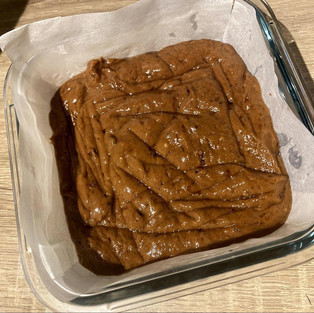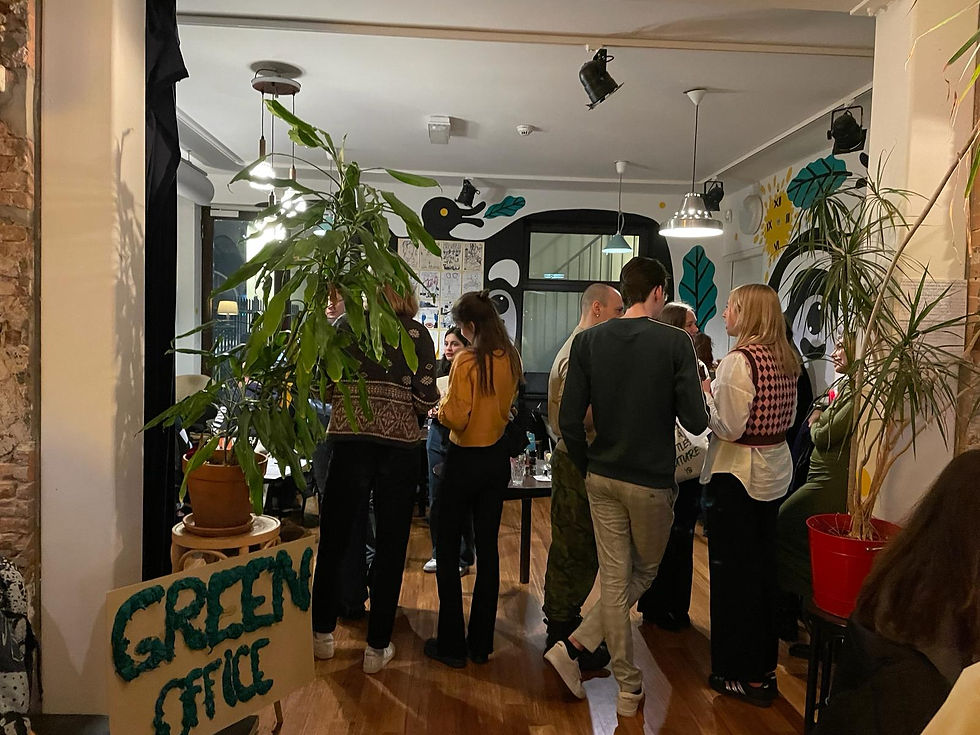My Week-long Vegan Challenge
- Green Office

- Feb 18, 2021
- 8 min read
I wonder how many of you have kept your New Years resolution. Well, I really wanted to try going vegan and thought I'd share how it's going...
As people’s concern for the environment increases, the number of people who have taken on 'Veganuary' has skyrocketed. The organization conducts a month-long campaign to practice veganism every January to rethink our eating habits and their impact on the Earth and animals. During the 2020 campaign, more than 400,000 people took their pledge to try a vegan diet and in 2021,100,000 more people joined together.
Wait, what exactly is Veganism?
Veganism is, of course, defined as a plant-based diet avoiding all animal foods such as meat, dairy, eggs and honey - as well as avoiding animal-derived materials, products tested on animals and places that use animals for entertainment (‘The Vegan Society’,1944). I thought I’d mention this because it can get confusing with all the diets out there:
Lacto-vegetarian: diets exclude meat, fish, poultry and eggs, as well as foods that contain them. Dairy products, such as milk, cheese, yogurt and butter, are included.
Ovo-vegetarian: diets exclude meat, poultry, seafood and dairy products, but allow eggs.
Lacto-ovo vegetarian: diets exclude meat, fish and poultry, but allow dairy products and eggs.
Pescatarian: diets exclude meat and poultry, dairy, and eggs, but allow fish.
Vegan: diets exclude meat, poultry, fish, eggs, dairy products and honey— and foods that contain these products.
Why did I want to make the change?
I'm Sungmin from South Korea and have been living in Amsterdam for over two years. Korean cuisine is very diverse with both meals full of vegetables and meat-oriented foods as well. Also, one thing to be aware of about Korean food if you're a vegan is that some foods often contain animal products such as beef bone and fish sauce in the process of making. Thus, it can often be missed if you aren't paying close attention. Vegan was not a widely applied concept in Korea till I left there a few years ago. I also thought veganism or vegetarianism is a lot far from me as it's hard to implement. Vegan/vegetarian restaurants and vegan options were just a few and hard to find. Thus, the concept of normal but slightly different could not be associated. As you have to be unique and try very hard to be a vegan, like you can't go to any restaurant, find a place with vegan options and leave the journey for it, it was not easy to apply. However, I saw it has changed, as environmental issues have arisen. More and more people start to change but yet in the beginning stage.
Living in the Netherlands makes me look back on my eating journey. Vegetarian culture is well spread in our daily life. Of course, there are plenty of vegetarian people back in my town, but here is a bit different. Vegetarianism is not a little different from the norm; instead, it's well-accepted as an ordinary culture, and its social culture is supported well. This surrounding environment has educated me and naturally spotted myself reducing the amount of meat consumption. I'm not a vegan before and not even a vegetarian. Just a person who's trying my best to eat as little meat as possible. When I was not familiar with veganism, the barrier seemed high to me. Could the complete cutting off the eating animal products be a sustainable challenge for me? The animal products are consciously and unconsciously deeply embedded in my life; how can I cut them off? With these doubts, I decided to start with a tiny step, a week vegan challenge. I’ve broken down my week, what I ate and the places I went to in Amsterdam making it easier for you to try Veganism out for yourself!
Day1.
Started Monday morning with grocery shopping. Purchasing vegetables is always a reasonable price here. The total spending was not as expensive as what I usually paid. If I regularly consumed the meat product, I could compare whether it’s cheaper to shop as a vegan or not, however I don’t really purchase meat products, I couldn’t really compare the price.

Before grocery, I was thinking of going to a vegan supermarket which is newly opened in the West, but the section in the nearby supermarket was large and diverse enough to purchase the vegan product that I needed.

When I shopped in the grocery, one thing I struggled with was snacks. Many snacks contain milk, eggs, and honey. It was hard to find some snacks and dessert which didn't contain those.
And the most helpful thing in shopping was the vegan mark. At first, it was confused with Vega marks, but Vega stands for Vegetarian. Most of Albert Heijn PB products are indicated in their own green color label. So it was really easy to recognize whether that product is vegan or not, but it was not applied to every product.


It’s dinner time. I decided to make a vegan gimbap. Gimbap is a Korean food that rolls the various ingredients with rice by seaweed sheet. Normally, in gimbap, you can actually put whatever you want. What I usually put in is tuna, fried eggs, cheese, ham, and carrots. But to make vegan gimbap today, I replaced the eggs and ham into the tempeh and replaced the normal cheese into a plant-based cheese. Also, add a more chewy texture and add beetroot here, but I didn’t like the taste of beetroot. Is it only me who feels the soil taste from the beetroot? To be honest here, I screwed up a bit the rolling gimbap here, as you can see in the picture the gimbap was actually exploded.
Day2

I started my day by taking supplements. I’m taking vitamin D, Vitamin C, probiotics, and Omega 3. Most of omega 3 is coming from fish oil. But did you know that there is a vegan omega 3? Like this, some supplements contain animal products, so caution is needed when you purchase.

I made a gimbap again to combat yesterday’s failure. I made rice moister, and it was the key and look! I succeeded in making a perfect gimbap. Ah, also, as I told you, I hated the beetroot flavor, so I removed it:
Day 3

Had a mashed potato sandwich. Mayonnaise for mashed potatoes was replaced with vegan mayonnaise. The taste of vegan mayonnaise was a bit sour than normal mayonnaise, but it’s safe to say that this is good enough to replace the mayonnaise. And obviously, the sandwich was excellent.
In the afternoon, I started to crave some sweet snacks, as I didn’t have any as I couldn’t find some from the grocery. So, I decided to make some sweets myself.
The menu is gonna be vegan banana bread. The butter would be replaced with plant-based oil. And the main part of this recipe is replacing the eggs with chia seed with a bit of water, then it’ll turn into a texture of the eggs. Vegan banana bread had no huge difference with normal banana bread.
Day4

You might be surprised with this strange ingredient, but this is dried seaweed, so I soaked in the water and made a curry udon with vegetables.

Day5
Had left over vegetable curry, this time with rice.

Vegan baking time again. Made red velvet cake with vegan ingredients. Milk, fresh cream and butter had been replaced into plant-based oil, oat milk, and plant-based yogurt. Also, the frosting was made with all plant-based ingredients, with margarine and vegan cream cheese.
Here we go, the perfect vegan red velvet cake.

Day6
On Saturday, I went out and spotted a nice vegan takeaway. “Root” is placed at the southside of the vondelpark and everything in there was plant-based. Had a nice wrap called ‘asian’ and it was literally awesome.


Day7

It was a snowy day. The weather was freaking cold so the warm soup and hot coffee was essential outside. I went to the ‘de soepbar’ and ‘ lot61’ in Oud West and both locations had a vegan option.

When I got home, it was so cold that I craved warm food again. Amongst this a full collection of ramens, most of them contain meat products in them. I chose Veggie Soon ramen, which can be found easily in Albert heijn and with a vegan mark. The flavor was a bit mild than usual ramen but still comforted me in the cold weather.
Finally I finished my vegan week with Sunday night’s veggie ramen. I felt a week was quite short to feel and learn something deeply, however I believe that any tiny step is important.
How was my week?
Eating meals didn't have any huge difficulties. However, snack parts have bogged me down. As you know, most sweet snacks contain dairy products and eggs. I could find only one type of sweets in the section, which is Speculaas. Otherwise, I had to go to some vegan bakery or had to make it myself. And if I want some dairies, I had to find substitutes, and that was where the most extra cost was incurred. But they were not enormously more expensive than originals. Some products were just the same as originals or slightly (approx.20%) more expensive. Apart from that, I had no difficulties at all.
Some Instagram accounts helped me a lot. Firstly, @huh_is_this_vegan; this account tells us about vegan products in the Netherlands that we didn't usually recognize. @vegan_veganfood, they show easy vegan recipes, especially their reels, which encouraged me to cook more delicious vegan foods.

Additionally, one more thing which was helpful was the filter function in Albert Heijn'sHeijn's application. On my first grocery shopping, I spent quite a lot of time finding out whether that product is vegan or not; however, using the filter function in an app that I can filter out the vegan products helped me reduce wasting time to figure out.
How does this help our environment?
The answer is obviously yes. According to Vegan society, there is 15,500 litres of water needed to produce 1 kg beef, contrasted with 180 litres for 1 kg tomatoes and 250 litres for 1 kg potatoes. If you today chose one substitute or replaced your meat into a vegan, then you save at least a few thousand water consumption. With just one replacement, we can save several times the amount of water we usually try to save in our daily lives.

In another perspective of environmental pollution, according to The Guardian, Supermarkets and fast food outlets are selling chicken fed on imported soya linked to thousands of forest fires and at least800 sq km of tree clearance in the Brazilian Cerrado. Brazilian Cerrado is a tropical savannah that covers 2 million sq km, which is 22% of the country. As of now, around 27,000 properties in the Cerrado had completed deforestation and 48% of properties were non-compliant with the requirements of Brazil’s forest code. The study found around 20% of soya trades and 17% of meat trades from Brazil's Amazon and Cerrado biomes to the European Union "might be defiled with illicit deforestation".
Additionally, the broadcaster, Chris Packham said with the evidence that soya produced in felled Brazilian rainforest had been used to feed chickens sold in UK supermarkets and fast-food outlets: “If you put that chicken in your mouth, you’re connecting yourself very directly with deforestation in South America.”
Self-reflection
To say vegan is difficult to implement, there are tons of substitutes around us. Especially in Amsterdam, you can reach all essential vegan products and substitutes at the nearby supermarket, and there are plenty of vegan restaurants all around the city even if it's not a vegan restaurant, many restaurants have a vegan option.
I started to think back how Amsterdam became a relatively vegan friendly city and has an infrastructure for veganism. And then I ended up thinking about a kind of person who is trying to think about sustainability, animal rights or whatever the reason and every one of these people came together to form a society where vegan culture is encouraged. It won’t touch you hard but the questions like “Do you have a vegan option?”, “Is this vegan?” These kinds of questions will become an opinion of society for businesses, and those actions will be gathered to create a more vegan encouraged society like businesses make more vegan-friendly products, I hope you enjoyed following my week long vegan journey and that you’d like to try it for yourself!





















